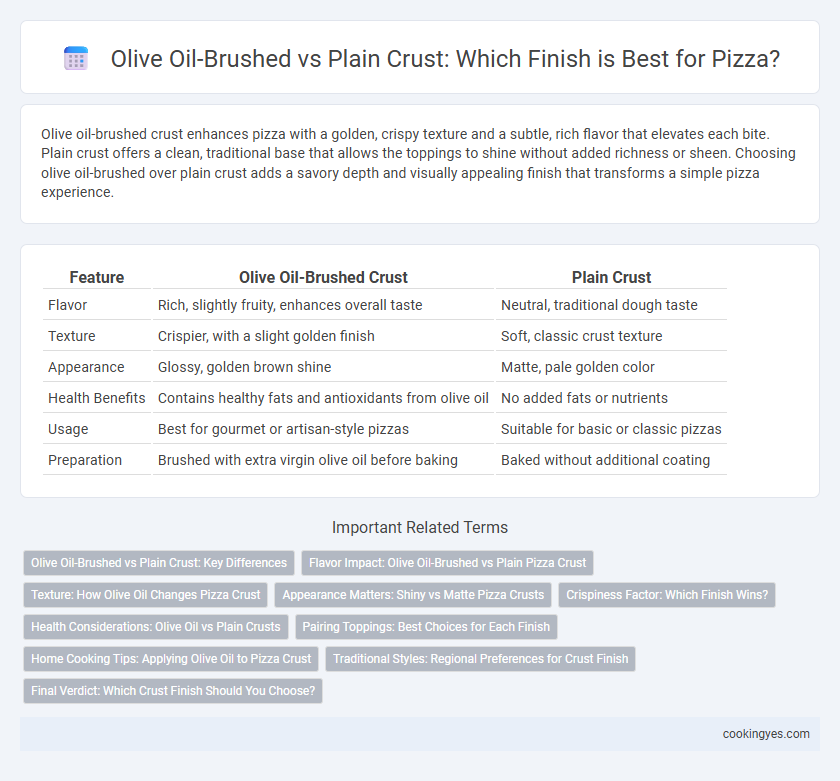Olive oil-brushed crust enhances pizza with a golden, crispy texture and a subtle, rich flavor that elevates each bite. Plain crust offers a clean, traditional base that allows the toppings to shine without added richness or sheen. Choosing olive oil-brushed over plain crust adds a savory depth and visually appealing finish that transforms a simple pizza experience.
Table of Comparison
| Feature | Olive Oil-Brushed Crust | Plain Crust |
|---|---|---|
| Flavor | Rich, slightly fruity, enhances overall taste | Neutral, traditional dough taste |
| Texture | Crispier, with a slight golden finish | Soft, classic crust texture |
| Appearance | Glossy, golden brown shine | Matte, pale golden color |
| Health Benefits | Contains healthy fats and antioxidants from olive oil | No added fats or nutrients |
| Usage | Best for gourmet or artisan-style pizzas | Suitable for basic or classic pizzas |
| Preparation | Brushed with extra virgin olive oil before baking | Baked without additional coating |
Olive Oil-Brushed vs Plain Crust: Key Differences
Olive oil-brushed crust enhances pizza with a richer flavor profile and a golden, crispy texture, while plain crust offers a more neutral base that highlights the toppings. The oil creates a slight sheen and prevents dryness, contributing to a moist bite and improved browning. In contrast, plain crust maintains a traditional, chewy consistency without added richness or aroma.
Flavor Impact: Olive Oil-Brushed vs Plain Pizza Crust
Olive oil-brushed pizza crust enhances flavor by adding a rich, fruity aroma and a slight crispness that plain crusts lack. The oil's subtle bitterness and peppery notes complement the dough's natural sweetness, creating a more complex taste experience. In contrast, a plain crust offers a neutral base, allowing toppings to dominate without additional flavor layers.
Texture: How Olive Oil Changes Pizza Crust
Olive oil-brushed pizza crust offers a crispier and slightly glossy texture compared to a plain crust, which tends to be drier and more brittle. The oil penetrates the dough surface, creating a crunchy outer layer while retaining moisture inside, enhancing chewiness. This treatment also prevents the crust from absorbing excess sauce, preserving its structural integrity during baking.
Appearance Matters: Shiny vs Matte Pizza Crusts
Olive oil-brushed pizza crusts develop a shiny, golden-brown finish that enhances visual appeal and signals a rich, flavorful bite. Plain crusts tend to have a matte, slightly dull surface, emphasizing a traditional, rustic look. The glossy shine from olive oil also helps retain moisture, contributing to a softer texture compared to the drier, crispier plain crust.
Crispiness Factor: Which Finish Wins?
Olive oil-brushed crust enhances crispiness by promoting even browning and a slightly crunchy texture, creating a more flavorful and satisfying bite compared to a plain crust. The oil's fat content helps lock in moisture while preventing the crust from becoming dry or tough, resulting in a balanced crisp finish. Plain crusts tend to be drier and less textured, often lacking the appealing golden color and depth of flavor found in olive oil-brushed options.
Health Considerations: Olive Oil vs Plain Crusts
Olive oil-brushed pizza crusts provide heart-healthy monounsaturated fats and antioxidants, promoting better cardiovascular health compared to plain crusts. The oil also enhances nutrient absorption and adds anti-inflammatory benefits absent in plain dough finishes. Choosing olive oil over a plain crust finish can improve overall nutrition without significantly increasing calories.
Pairing Toppings: Best Choices for Each Finish
Olive oil-brushed crust enhances the flavor profile of Mediterranean toppings such as sun-dried tomatoes, fresh basil, and feta cheese, creating a rich, aromatic base. Plain crust provides a neutral foundation that pairs well with robust ingredients like pepperoni, mushrooms, and aged mozzarella, allowing their flavors to stand out. Selecting the right crust finish amplifies the overall taste experience by complementing specific topping combinations.
Home Cooking Tips: Applying Olive Oil to Pizza Crust
Brushing pizza crust with olive oil before baking creates a golden, crispy texture while adding rich flavor that plain crusts lack. Olive oil enhances moisture retention, preventing the crust from drying out during home cooking. For best results, use extra virgin olive oil evenly brushed on the edges to achieve a perfectly finished pizza crust.
Traditional Styles: Regional Preferences for Crust Finish
Traditional Italian pizza styles reveal distinct regional preferences for crust finish, with Neapolitan pizzas typically featuring an olive oil-brushed crust to enhance flavor and promote a tender, slightly crispy texture. In contrast, Roman-style pizzas often favor a plain crust finish, emphasizing a thin, crunchy base that showcases simplicity and crispness. These regional variations reflect centuries-old techniques that balance texture and taste, highlighting how crust finishing influences the overall authenticity of a pizza.
Final Verdict: Which Crust Finish Should You Choose?
Olive oil-brushed crust delivers a golden, crisp texture with a rich, aromatic flavor that enhances the pizza's overall taste, making it ideal for those who enjoy a savory, gourmet finish. Plain crust offers a neutral, slightly chewy base, allowing the toppings' flavors to shine without added richness, perfect for traditionalists seeking authenticity. Choosing between olive oil-brushed and plain crust depends on whether you prefer an extra layer of flavor and crunch or a simpler, classic pizza experience.
Olive oil-brushed vs Plain crust for finish Infographic

 cookingyes.com
cookingyes.com